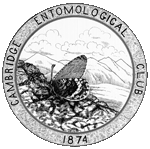
| January 2008: Psyche has a new publisher, Hindawi Publishing, and is accepting submissions |
Article beginning on page 68.
Psyche 3:68, 1880.
Full text (searchable PDF)
Durable link: http://psyche.entclub.org/3/3-068.html
The following unprocessed text is extracted from the PDF file, and is likely to be both incomplete and full of errors. Please consult the PDF file for the complete article.
and is probably identical with ZinO(fendron- plate), is very much like the larva of our ella.
T. malifolieUa, but the head of margvinea, Ttschwia.
as figured, is darker than that of mulifo- In all of the species of this genus of Kella, and the last. three segments, espe- which I have traced the life history (T. dally the last one, in the fignre, are too maKfoliella, T. quercivorella and T. per- short and narrow. The wings of the im- a ) , there
are the dame number of ago of marginea, as figured, are paler than moults as in the greater number of lepi- those of malifolieUa. The larva of maU- doptera, viz., four (or five, if we include foliella is also slenderer than that of mar- the moult into the pupal state) ; and there ginea, and more moniliform, while each are no marked differences, either in color segment has on each side three hairs, which or ~tructure, between the same larvae at are not represented in the figure of mar- different stages of growth. The oak-feed- gwiea. MarginM is 'perhaps nearer - or ing species are more readily distinguished as near -our T. aenia I?. & B., which, from each other by the character of the
like marginea, mines bramble leaves. The mines, than by the appearance of either mine of mavqkea is, however, wider and the larva or imago. Mr. Stainton's figure more irregolar than that of aenia. of T, marginea (Nat. Bat. Tin., v. 3,
TRANSFORMATIONS OF NACERDE8 MJSLANUSA.
BY HENEY LOEING MOODY,
MALDFX, MASS.
As far as I am aware, nothing is yet
was hardly perceptible. At the end of
known of the transformations of this very seven months the largest specimens meas- common beetle.
At various times I have ured barely more than two mm. long ; in hunted assiduously for the larva, but with- eleven month8 four mm., and at the be- out success. Tbxnkhg better luck might ginning of the fifteenth month all were follow from trying to obtain larvae in an- dead. It would be somewhat remarkable
other way, I captured a lot of the beetles for any larva to sustain life so long under with the purpose of getting the eggs. conditions altogether unfavorable. I am From the fact that the beetles are abundant confirmed therefore in thinking that pine, about buildings with open rafters, I con- or some one of the coniferous woods, in a eluded that dry pine wood waa the food of dry state, is the food of this larva, but the larva, and confined the females in a think I made a mistake in keeping the vee- vessel with a quantity of dry " punky " sel so tightly closed as to exclude the air. pine. They laid their eggs freely, and in The eggs of Nacerdes are cylindrical, a eight days tire youag appeared ; when fraction over 1 ~ m . long, a little more than firat hatched they measured a fraction over three times as long as their greatest breadth, one mm. long. At intervals of one or two tapering somewhat toward each end, some- weeks I measured specimens, and, singu- tiroes slightly curved, rounded at the ends. lady enough, though apparently in good Color white, somewhat translucent, with a health, their growth after the first few days portion at each end ~emi-transparent.
================================================================================
Volume 3 table of contents